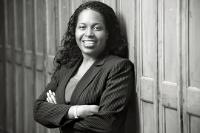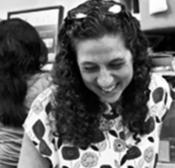
Bright and Early
Spurred by an explosion of research led by TC, the nation is placing big bets on early childhood learning and development
If all goes well, Teachers College neuroscientist Kimberly Noble will soon begin handing over $4 million to a group of new mothers. The goal: to see if a boost in monthly income translates into bigger brains for their children. In a widely-reported study last spring in Nature Neuroscience, Noble found that family income directly correlated with increases in the surface area of brain regions implicated in language and executive function. Children in the poorest families had up to 6 percent less brain surface area than those in the richest group. If her new study bears out this seeming cause-effect connection, the policy implications will be tough to ignore. “Manipulating socio-economic circumstance can be difficult,” Noble says, “but giving people money isn’t.”
Striking While the Iron is Hot
It’s hardly news that children’s earliest years shape their subsequent development. In the 1960s, Edmund Gordon, now TC Richard March Hoe Professor Emeritus of Psychology & Education, found that the federal Head Start program narrowed the achievement gap between wealthier white children and lower-income children of color. Several long-term studies co-led by TC psychologist Jeanne Brooks-Gunn, Virginia & Leonard Marx Professor of Child Development & Education, have unequivocally linked socio-economic status to learning and health outcomes. In the Perry Preschool Study, inner-city three- and four-year-olds in the 1960s who attended a play-based learning program supplemented by home visits later achieved higher graduation rates, greater earnings, fewer arrests and less reliance on public assistance. In the 1980s, psychologists Betty Hart and Todd Risley found that by age four, children from wealthy families were exposed to 30 million more words than children on welfare. And the list goes on.
Rita Gold Center
A $500,000 gift from the Cleveland H. Dodge Foundation, headed by TC Board Co-Chair and Campaign Vice Chair William Dodge Rueckert, will enhance education, research and training at the Rita Gold Early Childhood Center. Read more >>
“We know how poverty, risk and other environmental and interpersonal factors affect early development,” says Susan Recchia, Professor of Education and Coordinator of TC’s Program in Early Childhood Special Education. “Yet the nation has been slow coming to terms with the devastating impact.”
More recently, though, a flood of new findings in fields ranging from genetics to economics has sparked real change.
“Almost at every turn, in a variety of disciplines, the pendulum is swinging to support increased investment in young kids,” says Sharon Lynn Kagan, Virginia & Leonard Marx Professor of Early Childhood & Family Policy.
In 2007, a commission spearheaded by Kagan recommended shifting $60 billion to support preschool nationwide. In 2013, the Obama administration announced its “Preschool for All” initiative, and today states and municipalities increasingly provide universal preschool. New York City launched its own program last year.
Clearly, the notion that, as Noble says, “the first three years are a time of massive brain plasticity,” has arrived, and with it, recognition that many young children are deprived of essential learning opportunities. But all the ferment also suggests another possibility: Children who are learning could be learning much more.
Eighteen Months and Counting
On the eleventh floor of Thorndike Hall, Karen Froud’s team in TC’s Neurocognition of Language Lab apply electrodes to participants’ heads and decipher graphs of brain activity. The technique, electroencephalography (EEG), shows the development of specific brain functions by measuring responses to specific stimuli.
Small Talk:
Herbert GinsburgHerbert Ginsburg, who has video-taped interviews with hundreds of children, says important mathematical ideas and skills can be learned by age four, “yet research shows that most pre-K teachers do little with math or else do it badly.” Many have math anxiety, or lack insight into young children’s mathematical thinking or ideas that under-lie mathematical operations.
“Six-month-olds have largely refined the sound system of their language,” says Froud, Associate Professor of Neuroscience & Education. “They can distinguish even earlier between their own and other languages, but that’s when brain material becomes specialized to respond differentially to different speech sounds.” Yet, second language instruction typically begins in the sixth grade — “very late to acquire a new phonological system.”
Other disciplines, too, are finding that young children can handle more than they currently receive. As early as age three, children “know that if you put more food on the plate, you’ve got more food than you had before — which is the essence of addition,” says Herbert Ginsburg, Jacob H. Schiff Foundations Professor of Psychology & Education. “Through various activities, you can build on that understanding.”
Ginsburg, who has videotaped hundreds of children engaging in flexible interviews about their “everyday math,” says important mathematical ideas and skills can be learned by age four, “yet the research shows that most pre-K teachers do little with math or else do it badly.” Many have math anxiety, or lack insight into young children’s mathematical thinking or the ideas that underlie mathematical operations — training that colleges and universities rarely provide.
With the advent of the Common Core State Standards, Ginsburg, who teaches a course called The Development of Mathematical Thinking for TC early childhood education students, sees preschools caught between a “false dichotomy” of structured, assessment-oriented lesson plans and free play.
“Free play is wonderful,” he says, “but research shows it should be supplemented by intentional, exciting instruction.”
Similarly, “most children have the brain capacity to deal with all kinds of material,” Froud says, “but sitting them at a desk eight hours daily isn’t development. To get young kids engaged with language, put them in a language-rich setting using vision, sound and the environment. Make it part of what they do.”
Children, Behave!
Nine floors below Froud’s lab, toddlers at the Rita Gold Early Childhood Center prepare to visit the park. One boy shuts off the lights to signal clean-up time. The floor is strewn with blocks and toys — messiness to a parent, but to staff members at the Center, where student-teachers work during the practicum phase of TC’s Early Childhood Education program, something much richer.
“Kids leave behind in the classroom something they constructed,” says Emmy Fincham, a toddler room lead teacher. “We can draw from these experiences to create space for children’s agency and help them develop their self-regulation skills.”
The Center, which serves infants, toddlers and preschoolers of Columbia-affiliated families, practices what director Patrice Nichols calls an “emergent curriculum” built on each day’s experience. An imagined trip to Jupiter becomes a teachable moment about gravity and temperature. A reading of the children’s classic, The Little Red Lighthouse and the Great Gray Bridge, prompts a trip to the real Little Red Lighthouse under the George Washington Bridge and an investigation of New York City maps and landmarks.
“What happens in the classroom comes from the lived life of the classroom,” Nichols says. “We create learning opportunities by noticing what children find meaningful and interesting. It’s different than judging your success based on kids accomplishing predetermined goals.”
Fincham and fellow teacher Tran Templeton read toddlers’ body language, welcome children to re-purpose materials for unexpected play scenarios and communicate respect as kids discover who they are and what it means to be part of the classroom community.
“Student teachers notice we avoid ‘baby talk’ and talking down to the children,” Fincham says. “They’ll say, ‘You talk to them like people.’”
Taking Play Seriously
Maria Montessori’s observation that “play is the work of the child” was founding TC doctrine, but in an era emphasizing grades and test scores, today’s faculty are newly determined to validate the approach.
“Some people say, ‘So much time gets wasted on breakfast and outside play,’” says Mariana Souto-Manning, Associate Professor of Early Childhood Education and Coordinator of TC's Early Childhood Education Program. “Well, those are the learning times. Young children need room to develop as expert players and communicators.”
Denise Ross
Changing Reading Behavior“WE CAN’T REWRITE the development of older students who struggle with literacy,” says Denise Ross (Ph.D. ’98). “But our knowledge of early childhood can help them.” With her TC mentor, Professor of Psychology & Education Douglas Greer, Ross, now Associate Professor of Psychology at Western Michigan University, used behavioral methods to help children with language delays expand their verbal repertoires. More recently, she’s used behavioral methods to help older elementary school students who weren’t reading to learn phonics (building blocks of sound).
“Play is seen as emotionally good for kids, but not always as an intellectual part of building curriculum,” says Haeny Yoon, Assistant Professor of Early Childhood Education. Yoon recently observed a successful kindergarten writing workshop in which “the time was mostly spent playing, but play was what got them to write at all.” The make-believe scenarios and dynamics of play infused the children’s drawings and writing, teaching them, for instance, to correctly spell one another’s names. “If kids need language, they’ll use it,” Yoon says.
In another study, Yoon documented “literacy moves” in kindergartners’ playtime whiteboard scribbles, drawings and even items they’d thrown away. “There’s real power in teachers taking seriously what kids are doing when they play,” she says.
Both Souto-Manning, who is Brazilian, and Yoon, the daughter of Korean immigrants, believe play reveals the knowledge and abilities of young children from different cultures.
“Vygotsky wrote that ‘in play, a child always behaves beyond his average age, above his daily behaviors; in play it is as though he were a head taller than himself,’” says Souto-Manning, referring to early 20th century Soviet psychologist Lev Vygotsky. “Young children know a lot through their families and communities, and are capable communicators even if not in the so-called standard English. Pre-K teachers must be researchers who identify and tap into these funds of knowledge.”
Encouraging native and second languages is essential. “Many young children enter classrooms as bilinguals or emergent bilinguals, and they are constantly operating within and across the rules of different languages,” Souto-Manning says. “That’s an asset, but historically it’s been seen as a deficit when measured against white, middle-class monolingual norms.”
Souto-Manning sees a need for African-American language to be regarded as “a legitimate and worthy language. It should not be erased so that children develop academic English.” Further, she proposes that reading comprehension can build from familiar contexts such as signs in a child’s neighborhood. “We must re-envision reading and writing as ‘reading and re-writing worlds,’ recognizing what children already know instead of focusing solely on letter-sound correspondence.”
Ready or Not?
Intentional play” can also reveal children’s broader social and emotional ability and serve as a context to practice and strengthen self-regulatory capacities — skills increasingly seen as more important to success than raw intelligence.
Small Talk:
Nathan HolbertWith maker technology (3-D printers, laser cutters), kids create their own imaginings. Concerned this opportunity is reaching only white males, TC’s Nathan Holbert studies ways to increase maker diversity. He believes girls and other underrepresented children who build toys for others will value making as a valuable way to connect to their community.
“Self-regulation plays a critical role in explaining children’s resilience in the context of adversity,” says Laudan Jahromi, Associate Professor of Psychology & Education. “These capacities may be one pathway through which children’s home environment impacts their academic behaviors.”
For the past six years, Jahromi has studied the families of over 200 low-income Mexican-origin teen mothers. She annually gauged the child’s and the teen mother’s development and the mother’s relationship with the child’s father, her own mother (often a de facto co-parent) and others in her life. One finding: conflict between co-parents when a child is three predicts early literacy, early math skills and social development at age five. An important mediating factor: children’s behavioral control at age four. Jahromi finds that conflict between co-parents typically results in less such “effortful control” by children, leading to worse outcomes in school and with peers.
“It’s important to teach self-regulation in pre-K, before kids begin relying on maladaptive strategies,” Jahromi says. “Executive functioning skills are central to self-regulation.”
One line of intervention is mindfulness — a term with different meanings, but which generally refers to programs that help kids regulate anger, sadness, fear and anxiety, sharpen their attention and develop empathy.
Not much is yet known about how mindfulness programs work or why one might be more effective than another.
“Different programs target different brain systems,” says doctoral student Trey Avery, who manages Karen Froud’s lab. In collaboration with researchers at TC’s National Center for Children & Families, Avery uses EEG to measure children’s levels of attention, and saliva samples to measure their stress hormone levels. His findings suggest that lower-income students doing daily mindfulness exercises in school engage their attentional networks differently. “It’s something you couldn’t tell by just looking at the child performing the task,” Avery says. The data, though, are hard to miss: The children Avery has studied outperform higher-income children who aren’t engaged in mindfulness practices.
Shaping a New Landscape
It’s clearly a time of innovation in early childhood education. Yet, who benefits is still largely a matter of zip code.
“There’s a tremendous discontinuity in how Americans view early childhood education,” says Susan Recchia. “Some don’t see teachers’ work with children from birth to age three as a theater for learning, but instead, as a service to parents who work.”
In early childhood education, where settings are both public and private and vary dramatically, innovations rarely catch on systemically and sometimes create new headaches.
Small Talk:
Patrice NicholsTC’s Rita Gold Center practices an “emergent curriculum,” says director Patrice Nichols. “What happens in the classroom comes from the lived life of the classroom. We create learning opportunities by noticing what children find meaningful. It’s different than judging success based on kids accomplishing predetermined goals.”
“Many advances happen episodically,” says Sharon Lynn Kagan. “They are wonderful but can add to the inefficient, hodgepodge aspect of what we already have.”
This poses a dilemma that Kagan and Brooks-Gunn explore in a year-long seminar: With so much unknown, should we continue implementing universal pre-K?
Consider Head Start and Early Head Start, which serve low-income children, including many of color. Folding these programs into universal pre-K makes administrative sense, and, for many pre-K programs, could also improve racial diversity, which a recent study by Kagan and NCCF researcher Jeanne Reid found can positively affect children’s long-term attitudes and experiences.
But merging Head Start and Early Head Start, which are federal programs, into general pre-K, which is locally run, could be a bureaucratic nightmare. It could also penalize the very children the programs were designed to serve. Head Start and Early Head Start get more funding than universal pre-K precisely because they target low-income children, often of color. With the two programs in the general funding basket, would those children lose a valuable service?
Then, too, how to cost-effectively serve the youngest children? Quality center-based care provides benefits lacking in the poorest homes but costs more than home visits. Yet working parents of infants need child care outside the home.
Kagan hopes for answers as pre-K develops a “long-neglected infrastructure,” including standards, accountability, data-driven teaching, finance and professional development.
“It’s coming,” she says. “Early childhood education is like the women’s and civil rights movements. Social change doesn’t happen overnight.”
Read the print version as a PDF
-- Siddhartha Mitter
Color photography by Deborah Feingold
Published Thursday, Nov 5, 2015





